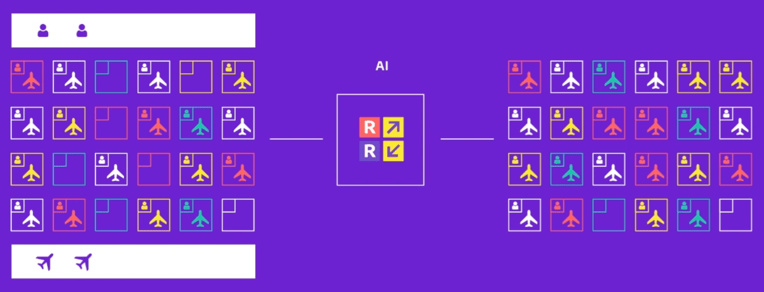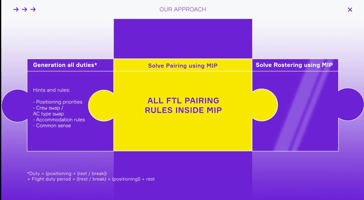Bushido (武士道, "the way of the warrior") is what we chose at Rosterize.
Key benefits for air fleet operators
Three years ago when we were contacted by one regional charter and scheduled operator to help them with crew planning. And although our team already had years of experience in Operational Research, we did not deal with the aviation industry. Our market research of optimization solutions uncovered the lack of options for small and midsized operators. We were brave enough to cover this lack. This year business aviation operators faced the same issues with crew planning as the small airlines.
To better understand our new customers' needs, we became a member of NBAA - the US National Business Aviation Association.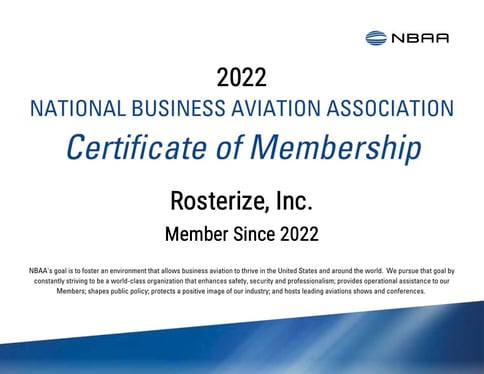
Let's talk a little bit about the difference in needs and requirements between big airlines and smaller airlines and business aviation operators. Let's start with the product capabilities smaller operators need.
Smaller airlines and business aviation operators have a more dynamic schedule and experience a permanent lack of pilots. As a result, they benefit from cross-rated pilots and crew swaps rather than avoid them. They cannot book a class for training in advance because if they send a complete group of pilots to a training center, they would not be able to cover the demand with the rest pilots.
And, of course, optimal crew pairings that could not be rostered to crew members without the manual corrections have a little sense to them. Fixed schedule for the next month? Forget it. Dynamic rescheduling, sometimes several iterations per day.Fair distribution of block hours is not enough. If one pilot had layovers only in some unpleasant destination, and another flue to exotic islands, you will get a chance that the first pilot left your company.
Every pilot matter and every minute matter were the operations' foundation.
Product capabilities are not the only point to be mentioned. Smaller operators need different implementation methodology and licensing models from the provider. Rosterize is a tool for people who used to manually schedule crew using Excel spreadsheets, sometimes large desks with markers. They cannot afford lengthy-lasting implementation; they cannot precisely determine the detailed business requirements; and they are permanently busy! That is why they need the iterative approach, step by step. Iteration after the iteration till the system's outcome is helpful. Life experience and the perception of planners are what we teach our algorithm during the lifespan.
The system needs to be controlled, but anyway, the joint work of a person and a machine is always more efficient than a work of a person and a machine separately.
All that I mentioned above and more led us to develop an unconventional holistic crew scheduling solution. We did not separate the crew planning into crew demand forecasting, pairing, rostering, and tracking products. Avoiding the traditional siloed approach has its pros and cons. The main advantage is the ability to play with data you lose if you divide the planning process into integrated but different pieces.
Crew manpower, pairing, rostering, crew tracking are just the different scenarios where we vary the input and output.
For example, we get the crew demand forecast if we do not fix the available crew sets. You can use Rosterize as the precise and provable crew demand calculator – the number of crew sets can be verified by crew pairings that can be rostered with the calculated number of crew sets.
If we do not consider OFF days, we get optimal OFF days distribution based on flight segments, sales forecast, and the crew requested OFF days and vacations.
Our pairings are flyable from the beginning; they do not need to be manually adjusted during the rostering,
Or even more, pairings are just the tracks for crew members. We can take it if it is convenient for the user, or we can work without pairings – the system will generate crew routes. Let's dig deeper into the benefits of genuinely holistic crew scheduling. Useful functional capabilities, business effects, and valuable business scenarios.
Let's start with the useful functional capabilities.
The vital capabilities of our system are following.
- Relative freedom in choosing the planning horizon, when it starts, ends; if some semifixed assignments could be updated
- We support scheduled and non-scheduled flights. Although If a user wants crew pairings for regular flights to look similar from week to week - we can do it
- Conservative and optimistic crew credentials. If some pilot has a mandatory check that will end inside of the scheduled period, we skip them from being assigned for the conservative planning or allow them to fly if some exam is assigned before the end of the period, or we do not take into consideration at all this check
- Some professional hates crew swaps because it is definitely a risky strategy. But we met a lot of operators who embrace crew swaps. Having cross-rated pilots leads to additional costs for training, but using our system, you can easily calculate does it is worth it?
- Probably you heard this saying: two lawyers three opinions?
What we learned from our projects is that there are no two identical opinions regarding the FTL rules of a given country. Every operator has their opinion on what is suitable, what is unacceptable, and what could be acceptable but not too often.
The meaning of the term fairness could be different. Of course, Starting from a number of flight days and block hours.
One of the most debatable topics is the business effects of any crew optimization system.
Let's be honest. The majority of cases where a customer proudly reports that they decreased the cost by 5 percent could not be verified. You cannot run your tests over the historical data to compare a schedule generated by the new tool with the actual data. Users like it so much, but there is no sense in comparing the results' metrics of several algorithms over some sample data. For example, you can get different results by changing the risk tolerance. That is why our favorite customers are those who know that they need improvement. However, we all need to inspire users with cases even with the debatable calculation methodology.
According to our cases, if an operator aligns Sales and OPS teams, it could lead to the additional crew capacity on its peak days or decreasing in crew demand. It is hard to consider all risks, even if you know them. Thus, if the system can automatically help avoid risky practices, it could significantly affect the total efficiency. Direct costs and potentially lost profits also must be considered. For example, positioning your crew on a low-cost carrier back home could be cheaper than a couple of days of accommodation
Ok, now I would love to share the top five scenarios where our holistic algorithm works. As I mentioned earlier, the same system works; we just need to change input and output data.
They are:
- Provable man-power, or crew demand calculation
- Optimal OFF days rostering for the period ahead
- Generating the Flight Schedule Adjustments
- Dynamic rescheduling
- Empowering the charter sales team with the actual crew and tail availability
Let us start with the provable crew demand calculation.
The primary purpose of this scenario is to calculate the minimal number of the crew sets the operator will need to cover the flight schedule or the crew demand represented in person-days.
The user defines the location for bases and potentially available crew sets with given credentials.Policy for vacation, sick leave, standby, and training also could be assigned as a fixed number per day, a percentage per team, or the average number of days per year.The result is not just a number of crew sets. This number could be verified with crew pairings and rosters that comply with all regulations. Recommended crew accommodation and positioning are also part of the system's final data set.This scenario is helpful for what-if analysis. For example, the value of cross-rated pilots, right seat captains, or a more risky strategy with crew swaps could be calculated.
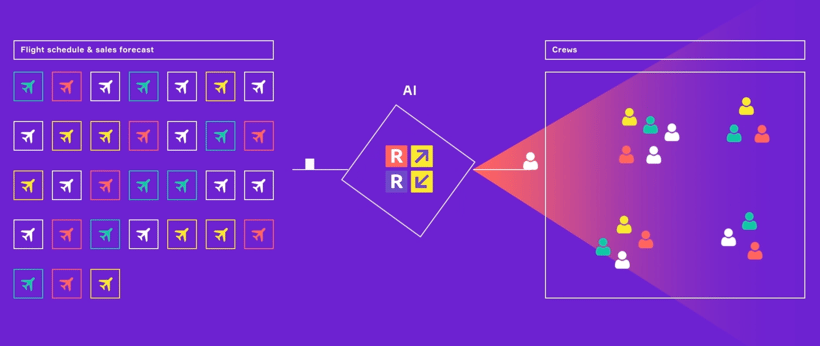
Crew OFF days rostering for the period ahead. This scenario is valuable for operators who, according to law, or union agreements, must assign crew OFF days in advance but still has some flexibility in selecting the exact days. The input data for this scenario is the predefined crew members with their credentials, pre-assigned vacation and training days, crew OFF days requests, and crew schedule days before the planning period. We need the second piece of data to allow the system to calculate the crew demand per day.
It could be the flight schedule, approved crew pairings, or the crew demand forecast. Different individual rules could be applied to follow the operator's business practices, like long-lasting positioning for pilots living far from the base or patterns for ON-OFF days. Crew demand forecast could be assigned for every day with a must-have and nice-to-have number of crew sets. Running this scenario with different rules is a convenient way to understand the impact on the crew availability.
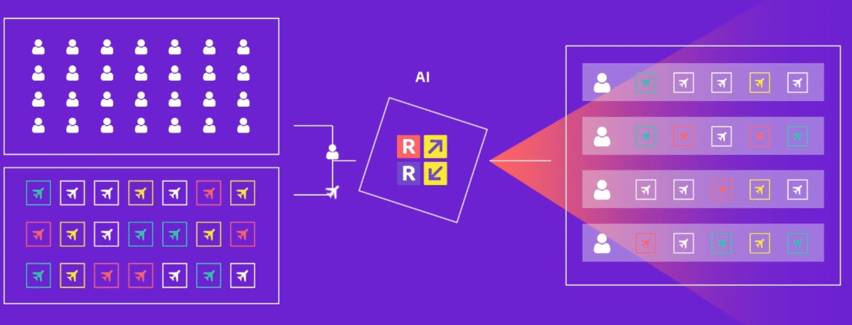
Flight Schedule Adjustments could be valuable for unscheduled operations and the strategic planning of regular flights. We presented this solution last month during the SSP study group. You can watch the recording. The main idea of this scenario is that a slight adjustment of the flight departure time allows the airline to reduce the cost of crew positioning and accommodation, increases crew utilization, and minimizes the risk of delays due to the unavailability of crews. In this scenario, we allow the system to change the flight segment's departure time in some range to find a more efficient solution. For example, to reduce crew sets number or crew-related costs. One test based on the peak month schedule of operators with 30+ tails demonstrated a 10 percent decrease in the total crew demand. It could be valuable, indeed.
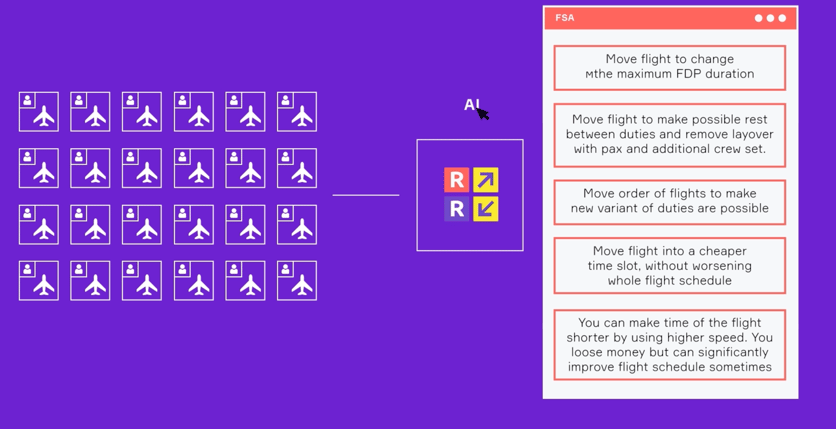
Probably, the most popular scenario is Dynamic rescheduling.
We provide the system with detailed and precise flights, stand-by, and crew schedules with explicit crew credentials as incoming data. Forecast regarding the chance of flight cancellation or the change of aircraft type increases the schedule robustness. Of course, crew-teaming, crew compatibility, crew fairness rules, individual preferences, risk tolerance, and limited accommodation capacity could be considered as well. For this scenario, we have a so-called published period where the system could change crew pairings and crew assignments if it is crucial.
For example, if an assignment somehow violates FTL due to delays or new flight segments were added, or there is no other way to assign crew. The system could also recommend new crew positioning based on the tickets in the GDS available. Some could name this scenario Crew Tracking or Crew recovery. If we run this scenario having crew pairings fixed, we get crew rostering generation. If we run this scenario allowing the system to regenerate crew pairings, we get crew pairing generation that considers actual crew availability precious in case of the pilot shortage.
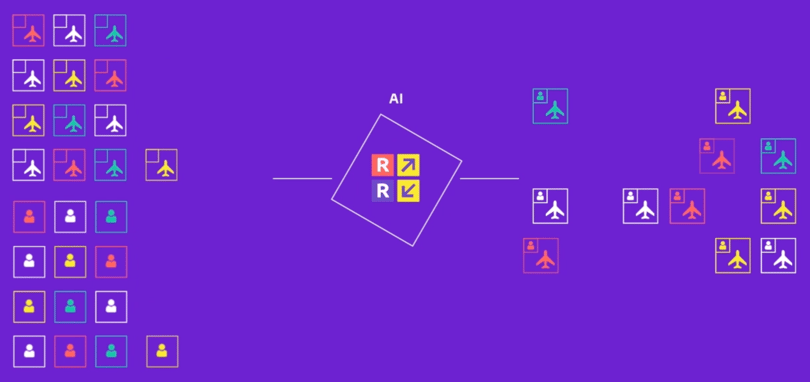
Charters sales support scenario was initially developed to empower the unscheduled operations of airlines but became interesting for the business jet operators that are fully unscheduled.
The pilot shortage shifted the operational bottleneck from tails to pilots. Now, having aircraft available for being chartered is not enough to provide a quote on the customer's request. As a result, well-established business processes of operators are not working correctly. The sales team must receive confirmation from the OPS team whenever they have a customer request. Online quotation tools of Bizav operators are not working as designed because there is always a chance of fault.
For each crew member, the system generates time intervals when they could be assigned to a new flight duty period or if their assigned FDP could start earlier or could end later without affecting other assignments and OFF days and follows the FTL rules. After that, we intersect these time intervals with the tails schedule. The result is a list of possible time gaps when the tails could be booked without any crew-related issues provided to sales and could be uploaded to the online quotation tools.
If there is no crew to fly the customer request, we could run the Dynamic rescheduling scenario to find out if it is possible to re-arrange the crew assignments without OPS team involvement. To increase the pilots' availability during the pilots' schedule generation, we consider the sales forecast as an additional source of requirements on crew availability.
